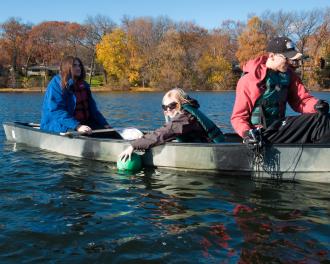Grant allows study of road salt’s influence in lakes
By Elena Hines
College of Arts and Sciences Staff Writer
The influence of road salt de-icers on the chemistry of Michigan lakes will be the subject of study by several Western Michigan University faculty, graduate students and undergraduate students following receipt of a grant from the Michigan Department of Environmental Quality.
This is the continuation of work that Dr. Carla Koretsky, dean of the College of Arts and Sciences, has been doing since 2009. Her research group has published a few papers and two students have completed masters’ degrees focused on this issue.
They have found that road salt gets into lakes and has a significant impact on their chemical and physical properties.
Woods Lake in Kalamazoo, for example, has a relatively small surface area, but is very deep. Stormwater sewers drain runoff, so whatever is put onto the street gets channeled into the lake … and accumulates there for decades.
Woods Lake has 200-250 times more chloride in it than a comparable lake in a rural area.
This also probably results in physical changes such as the lake’s ability to mix: “because there is so much salt at the bottom, the lake no longer turns over,” Koretsky said. “The wind is not able to mix it — it doesn’t mix now to the deepest part of the lake.”
There are parts of the world where people don’t use road salt due to concern about ecosystems.
“We don’t have to use it but we’ve chosen to do it,” Koretsky said of communities where road salt is used. “Expectations have changed over the years. We expect clear pavement as soon as possible. It’s just a societal expectation — we want safe roads.”
Alternatives, such as putting solar panels next to roads and sidewalks or using sand, are much more expensive, less efficient or come with other environmental costs.
With the grant, Koretsky and Dr. Kathryn Docherty, assistant professor of biological sciences, will be tracking the chemistry and microbiology of Woods Lake, Asylum Lake and a rural lake in Gobles, North Lake, for about a year and a half.
They have already been out twice already, and as weather permits, plan to go once a month to measure the amount of sodium chloride, dissolved oxygen, and microbial diversity in the lake.
“It’s a fascinating project,” said Koretsky, who said she fell into it by accident while teaching a course underwritten by the National Science Foundation. Her students were measuring chloride and found high salt concentrations in Woods Lake.
Initially she thought something must be wrong with the data, but soon realized the high concentrations were due to road salt. Koretsky’s aqueous geochemistry research group then began a more intensive investigation of how the input of salt was changing the lakes’ overall chemical and physical function.
More information:
Department of Geosciences
Department of Biological Sciences


